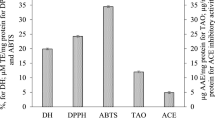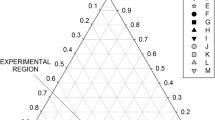Abstract
The aim of this work was to evaluate the physico-chemical, instrumental color and texture, and sensory qualities of restructured tilapia steaks elaborated with small sized (non-commercial) tilapia fillets and different levels of microbial transglutaminase (MTG). Four concentrations of MTG were used: CON (0 % MTG), T1 (0.1 % MTG), T2 (0.5 % MTG), and T3 (0.8 % MTG). In addition, bacterial content and pH shifts were also evaluated during 90 days of frozen storage. The different levels of MTG did not affect (P > 0.05) either the proximate composition of the restructured tilapia steaks or the bacterial growth during the frozen storage. MTG improved (P < 0.05) cooking yield and instrumental hardness and chewiness as well as sensory (salty taste, succulence and tenderness) attributes; strongly contributing to greater overall acceptance. Therefore, restructured tilapia steaks manufactured with MTG are potentially valued-added products with good consumer acceptance and better purchase-intention than steaks formulated with 0 % MTG.




Similar content being viewed by others
References
AOAC (2000) Official methods of analysis, 16th edn. Association of Official Analytical Chemists, Washington DC
APHA (2001) Compendium of methods for the microbiological examination of foods, 4th edn. American Public Health Association, Washington, DC
Binsi PK, Shamasundar BA (2012) Purification and characterization of transglutaminase from four fish species: effect of added transglutaminase on the viscoelastic behaviour of fish mince. Food Chem 132:1922–1929
Boles JA, Swan JE (1996) Effect of post-slaughter processing and freezing on the functionality of hot-boned meat from young bull. Meat Sci 44:11–18
Brewer MS, Novakofski JE (2008) Consumer quality evaluation of aging of beef. J Food Sci 73:S78–S82
Canto ACVCS, Lima BRCC, Cruz AG, Lázaro CA, Freitas DGC, Faria JAF, Torrezan R, Freitas MQ, Silva TPJ (2012) Effect of high hydrostatic pressure on the color and texture parameters of refrigerated Caiman (Caiman crocodilus yacare) tail meat. Meat Sci 91:255–260
Cervantes BG, Aoki NA, Almeida CPM (2010) Sensory acceptance of fermented cassava starch biscuit prepared with flour okara and data analysis with penalty analysis methodology. Braz J Food Technol 19:3–10
Chin KB, Chung BK (2003) Utilization of transglutaminase for the development of low-fat, low-salt sausages and restructured meat products manufactured with pork ham and loins. Asian Aust J Anim Sci 16:261–265
Civille GV (2011) Food texture: pleasure and pain. J Agric Food Chem 59:1487–1490
Cofrades S, López-López I, Ruiz-Capillas C, Triki M, Jiménez-Colmenero F (2011) Quality characteristics of low-salt restructured poultry with microbial transglutaminase and seaweed. Meat Sci 87:373–380
Conte-Júnior CA, Fernández M, Mano SB (2008) Use of carbon dioxide to control the microbial spoilage of bullfrog (Rana catesbeiana) meat. In: Mendez-Vilas A (ed) Modern multidisciplinary applied microbiology. Wiley-VCH Verlag GmbH & Co. KGaA, Weinheim, pp 356–361
Conte-Júnior CA, Peixoto BTM, Lopes MM, Franco RM, Freitas MQ, Fernández M, Mano SB (2010) Effect of modified atmosphere packaging on the growth/survival of Yersinia enterocolitica and natural flora on fresh poultry sausage. In: Méndez-Vilas A (ed) Current research, technology and education topics in applied microbiology and microbial biotechnology. Formatex, Badajoz, pp 1217–1223
Cozzo-Siqueira A, Oetterer M (2003) Effects of irradiation and refrigeration on the nutrients and shelf-life of tilapia (Oreochromis niloticus). J Aquat Food Prod Technol 12:85–101
Desmond E (2006) Reducing salt: a challenge for the meat industry. Meat Sci 74:188–196
Dimitrakopoulou MA, Ambrosiadis JA, Zetou FK, Bloukas JG (2005) Effect of salt and transglutaminase (TG) level and processing conditions on quality characteristics of phosphate-free, cooked, restructured pork shoulder. Meat Sci 70:743–749
Dornelles AS, Rodrigues S, Garruti DS (2009) Aceitação e perfil sensorial das cachaças produzidas com Kefir e Saccharomyces cerevisae. Cienc Tecnol Aliment 29:518–522
Flanagan J, Gunning Y, FitzGerald RJ (2003) Effect of cross-linking with transglutaminase on the heat stability and some functional characteristics of sodium caseinate. Food Res Int 36:267–274
Gonçalves AA, Passos MG (2010) Restructured fish product from white croacker (Micropogonias furnieri) mince using microbial transglutaminase. Braz Arch Biol Technol 53:987–995
Han M, Zhang Y, Fei Y, Xu X, Zhou G (2009) Effect of microbial transglutaminase on NMR relaxometry and microstructure of pork myofibrillar protein gel. Eur Food Res Technol 228:665–670
Heinz G, Hautzinger P (2007) Meat processing technology for small- to medium-scale producers, Food and Agriculture Organization of the United Nations regional office for Asia and the Pacific Bangkok. http://www.fao.org/. Available at. Accessed 9 March 2013
ICMSF (1986) Microorganisms in foods, sampling for microbiological analysis: principles and specific applications, 2nd edn. International Commission on the Microbiological Specifications for Foods, Toronto
Ionescu A, Aprodu I, Daraba A, Porneala L (2008) The effects of transglutaminase on the functional properties of the myofibrillar protein concentrate obtained from beef heart. Meat Sci 79:278–284
Jarmoluk A, Pietrasik Z (2003) Response surface methodology study on the effects of blood plasma, microbial transglutaminase and k-carrageenan on pork batter gel properties. J Food Eng 60:327–334
Jiang ST, Hsieh JF, Ho ML, Chung YC (2000) Microbial transglutaminase affects gel properties of golden threadfin-bream and pollack surimi. J Food Sci 65:694–699
Lima A (2008) Crescimento heterogêneo em tilápias cultivadas em tanque rede e submetidas a classificações periódicas. Rev Bras Eng Pesca 3:98–100
Macedo JA, Cavallieri ALF, Cunha RL, Sato HH (2010) The effect of transglutaminase from Streptomyces sp. CBMAI 837 on the gelation of acidified sodium caseinate. Int Dairy J 20:673–679
Mahmood WA, Sebo NH (2009) Effect of microbial transglutaminase treatment on soft cheese properties. Mesopotamia J Agric 37:1–9
Medri V, Medri W, Caetano Filho M (2009) Growth of Nile tilapia Oreochromis niloticus fed diets with different levels of proteins of yeast. Braz Arch Biol Technol 52:721–728
Merck (2000) Microbiology manual, 11th edn. Merck KGoA, Darmstadt
Monteiro MLG, Mársico ET, Teixeira CE, Mano SB, Conte-Júnior CA, Vital HC (2012) Validade comercial de filés de Tilápia do Nilo (Oreochromis niloticus) resfriados embalados em atmosfera modificada e irradiados. Ciênc Rural 42:737–743
Monteiro MLG, Mársico ET, Canto ACVCS, Costa Lima BRC, Lázaro CA, Cruz AG, Conte-Júnior CA (2013) Partial sodium replacement in value-added product of tilapia without loss of acceptability. J Food Sci (submitted)
Moreno HM, Carballo J, Borderías AJ (2008) Influence of alginate and microbial transglutaminase as binding ingredients on restructured fish muscle processed at low temperature. J Sci Food Agric 88:1529–1536
Moreno HM, Borderías AJ, Baron CP (2010a) Evaluation of some physico-chemical properties of restructured trout and hake mince during cold gelation and chilled storage. Food Chem 120:410–417
Moreno HM, Carballo J, Borderías AJ (2010b) Gelation of fish muscle using microbial transglutaminase and the effect of sodium chloride and pH levels. J Muscle Foods 21:433–450
MPA (2012) Boletim Estatístico da Pesca e Aquicultura, Ministério da Pesca e Aquicultura http://www.mpa.gov.br/. Available at. Accessed 9 March 2013
Pietrasik Z, Li-Chan ECY (2002) Response surface methodology study on the effects of salt, microbial transglutaminase and heating temperature on pork batter gel properties. Food Res Int 35:387–396
Puolanne E, Peltonen J (2013) The effects of high salt and low pH on the water-holding of meat. Meat Sci 93:167–170
Qiao M, Fletcher DL, Smith DP, Northcutt JK (2001) The effect of broiler breast meat color on pH, moisture, water-holding capacity, and emulsification capacity. Poult Sci 80:676–680
Ramírez JA, Martín-Polo MO, Bandman E (2000) Fish myosin aggregation as affected by freezing and initial physical state. J Food Sci 65:556–560
Ramírez JA, Uresti RM, Téllez-Luis SJ, Vázquez M (2002) Using salt and microbial transglutaminase as binding agents in restructured fish products resembling hams. J Food Sci 67:1778–1784
Ramírez JA, Del Ángel A, Velázquez G, Vázquez M (2006) Production of low-salt restructured fish products from Mexican flounder (Cyclopsetta chittendeni) using microbial transglutaminase or whey protein concentrate as binders. Eur Food Res Technol 223:341–345
Ramírez JA, Velázquez G, Echevarría GL, Torres JA (2007) Effect of adding insoluble solids from surimi wash water on the functional and mechanical properties of pacific whiting grade A surimi. Bioresour Technol 98:2148–2153
Resurreccion AVA (2003) Sensory aspects of consumer choices for meat and meat products. Meat Sci 66:11–20
Sanh T, Sezgin E, Deveci O, Senel E, Benli M (2011) Effect of using transglutaminase on physical, chemical and sensory properties of set-type yoghurt. Food Hydrocoll 25:1477–1481
Sen DP (2005) Advances in fish processing technology, 1st edn. New Delhi, India
Soccol MCH, Oetterer M, Gallo CR, Spoto MHF, Biato DO (2005) Effects of modified atmosphere and vacuum on the shelf life of tilapia (Oreochromis niloticus) fillets. Braz J Food Technol 8:7–15
Stone H, Sidel JL (1998) Quantitative descriptive analysis: developments, applications, and the future. Food Technol 5:48–52
Stone H, Sidel JL, Oliver S, Woosley A, Singleton RC (1974) Sensory evaluation by quantitative descriptive analysis. Food Technol 28:24–34
Suksomboon K, Rawdkuen S (2010) Effect of microbial transglutaminase on physicochemical properties of ostrich meat ball. As J Food Ag-Ind 3:505–515
Tseng TF, Liu DC, Chen MT (2000) Evaluation of transglutaminase on the quality of low-salt chicken meat-balls. Meat Sci 55:427–431
Uran H, Aksu F, Yi̇lmaz İ, Durak MZ (2013) Effect of transglutaminase on the quality properties of chicken breast patties. Kafkas Univ Vet Fak Derg 19:331–335
Uresti RM, Ramírez JA, López-Ariasa N, Vázquez M (2003) Negative effect of combining microbial transglutaminase with low methoxyl pectins on the mechanical properties and colour attributes of fish gels. Food Chem 80:551–556
Vidotti RM, Gonçalves GS (2006) Produção e caracterização de silagem, farinha e óleo de tilápia e sua utilização na alimentação animal. Instituto de Pesca. http://www.pesca.sp.gov.br. Available at. Accessed 15 March 2013
Wold S, Sjostrom M, Eriksson L (2001) PLS-regression: a basic tool of chemometrics. Chemometr Intell Lab 58:109–130
Acknowledgments
The authors would like to thank the Carlos Chagas Filho Foundation for Research Support in the State of Rio de Janeiro—FAPERJ (projects E-26/111.196/2011, E-26/103.003/2012 and E-26/111.673/2013) for financial support. We thank the regional cooperative (COOPERCRAMMA) for providing the samples and Ajinomoto for providing the MTG Activa enzyme. M.L.G. Monteiro would like to thank the National Council for Scientific and Technological Development—CNPq (project 551079/2011-8) for financial support.
Conflict of interest
None declared.
Author information
Authors and Affiliations
Corresponding author
Rights and permissions
About this article
Cite this article
Monteiro, M.L.G., Mársico, E.T., Lázaro, C.A. et al. Effect of transglutaminase on quality characteristics of a value-added product tilapia wastes. J Food Sci Technol 52, 2598–2609 (2015). https://doi.org/10.1007/s13197-014-1327-5
Revised:
Accepted:
Published:
Issue Date:
DOI: https://doi.org/10.1007/s13197-014-1327-5




